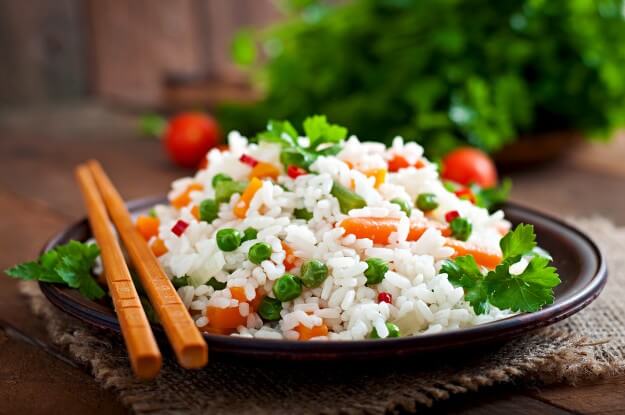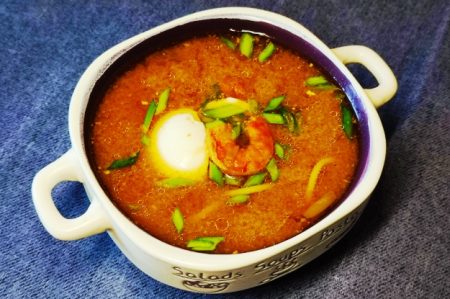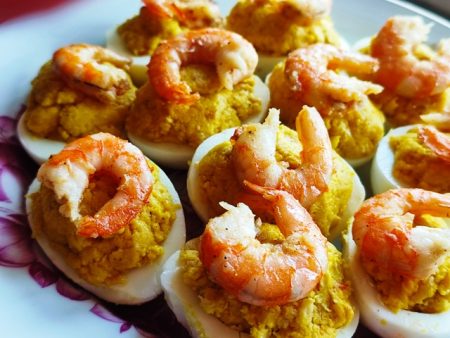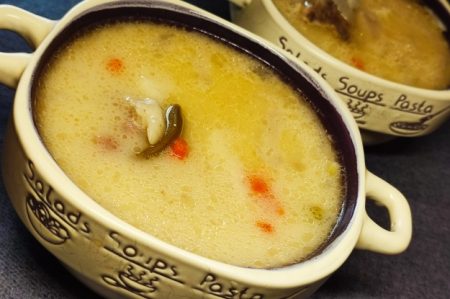Plain hot rice can be a delicious, light meal if you add vegetables and spices. Vegetarians and people on specific diets will love it. You can add whatever vegetables you have. We suggest taking carrots, green peas, hot peppers, and parsley for this recipe.
Directions
0/0 steps made- Everything is very simple. Boil rice in salted water for 20-25 minutes. Remove from the stove, drain off excess water, cover, and let it brew in a saucepan.
- Peel and boil whole small carrots. Use fresh green peas, or frozen. Cut hot peppers into rings, removing the center and seeds.
- Lightly fry hot peppers, green peas, and boiled carrots in olive oil for 5-10 minutes.
- Let the vegetables cool slightly and mix with the rice. Serve with chopped fresh parsley leaves.
Cooking Time
The cooking time of the vegetable rice recipe can vary depending on the type of rice used and the desired level of doneness for the vegetables. Here’s an estimated breakdown of the cooking time:
- Cooking the Rice: The cooking time for rice typically ranges from 15 to 25 minutes, depending on the type of rice and the specific brand. Follow the instructions on the rice package to determine the appropriate cooking time.
- Boiling Whole Small Carrots: Boiling small carrots will usually take about 8 to 10 minutes. You can test their doneness by piercing them with a fork; they should be tender but not overly soft.
- Lightly Frying Vegetables: The frying process can take approximately 5 to 10 minutes. Heat a pan with a small amount of olive oil and sauté the hot peppers and green peas until they are slightly tender and have a nice color.
The overall cooking time for this recipe, including preparation, should be around 45 to 65 minutes. Keep in mind that these times are approximate and may vary based on your stove’s heat, the size of the vegetables, and personal preferences for doneness.
It’s always a good idea to taste the rice and vegetables to ensure they are cooked to your liking before serving. Enjoy your vegetable rice dish!
Why hot rice is good for you:
This vegetable rice recipe is not only delicious but also offers several health benefits. Here’s why this recipe is good for you:
- Nutrient-Rich Vegetables. The addition of carrots, green peas, and hot peppers provides a wide range of essential vitamins and minerals. Carrots are rich in beta-carotene, which is converted to vitamin A in the body and supports vision and immune function. Green peas are a good source of fiber, protein, and various vitamins like vitamin K and folate. Hot peppers contain capsaicin, which may boost metabolism and have anti-inflammatory properties.
- High Fiber Content. Both rice and vegetables in this recipe contribute to the overall fiber content. Fiber aids digestion, helps maintain a healthy gut, and may even help with weight management by providing a feeling of fullness.
- Suitable for Vegetarians. This recipe is vegetarian-friendly, making it an excellent option for those following a vegetarian diet or looking for meatless meal ideas.
- Versatile and Customizable. The recipe encourages you to use whatever vegetables you have on hand, allowing for flexibility and creativity in your cooking. This variety ensures you get a diverse range of nutrients from different vegetables.
- Low in Saturated Fat. The use of olive oil for lightly frying the vegetables adds healthy monounsaturated fats instead of saturated fats, which are better for heart health.
- Parsley Benefits. The inclusion of fresh parsley provides additional nutrients like vitamins C, K, and folate. Parsley also contains antioxidants that may have anti-inflammatory and antimicrobial properties.
Generally, this vegetable rice recipe is a wholesome and nutritious option suitable for various dietary preferences. It’s an excellent way to enjoy a light, flavorful meal while providing your body with essential nutrients from a variety of vegetables. Enjoy it as a standalone dish or pair it with other protein sources for a well-rounded and balanced meal.
Video by Healthline
Why this recipe can be a risk to health
While the vegetable rice recipe described earlier offers many health benefits, there are some potential risks to consider:
- High Carbohydrate Content. Rice is a carbohydrate-rich food, and if consumed in large quantities without balancing it with other nutrients, it can lead to spikes in blood sugar levels. This can be a concern for individuals with diabetes or those trying to manage their blood sugar levels.
- Sodium Content. If the rice is cooked in heavily salted water or additional salt is added during preparation, the dish may become high in sodium. Excessive sodium intake can contribute to hypertension (high blood pressure) and increase the risk of cardiovascular problems.
- Cooking Methods. The lightly frying of vegetables in olive oil can be a healthier cooking method compared to deep-frying, but if too much oil is used, it can still add excess calories and fat to the dish.
- Allergies and Intolerances. This recipe includes common allergenic ingredients such as carrots and peas. Individuals with specific food allergies or intolerances to these ingredients should exercise caution or choose alternative vegetables.
- Food Safety. Proper food handling and cooking techniques are crucial to prevent foodborne illnesses. Ensure that the rice and vegetables are cooked thoroughly to avoid any risks of contamination.
- Individual Dietary Needs. While this recipe may suit many people, it might not be suitable for individuals with specific dietary requirements, such as those with certain medical conditions or dietary restrictions.
How to make this recipe healthier
To address these potential risks and make the recipe healthier:
- Choose whole grain or brown rice instead of white rice to increase fiber content and lower the glycemic index.
- Be mindful of the amount of salt used during cooking. Opt for herbs and spices to enhance the flavor instead.
- Use minimal oil for frying or consider steaming the vegetables for a lower-fat option.
- Customize the recipe to accommodate individual dietary needs and allergies.
As with any recipe, moderation is key, and it’s essential to balance this vegetable rice dish with a variety of other nutritious foods to ensure a well-rounded diet. If you have specific health concerns or dietary restrictions, it’s best to consult with a healthcare professional or a registered dietitian for personalized advice.
Serving Variation
There are several serving variations you can consider for the vegetable rice recipe to make it more interesting and appealing. Here are a few ideas:
- Protein Additions. While the original recipe is vegetarian, you can add some protein sources to make it a more substantial and balanced meal. Consider adding cooked and diced chicken, tofu, shrimp, or sliced boiled eggs.
- Nuts and Seeds. For added texture and nutrition, sprinkle some toasted nuts or seeds over the vegetable rice. Almonds, cashews, sunflower seeds, or sesame seeds would work well.
- Fresh Herbs. In addition to parsley, you can include other fresh herbs like cilantro, mint, or basil to enhance the flavor and aroma of the dish.
- Sauce or Dressing. Drizzle a flavorful sauce or dressing over the vegetable rice to give it a burst of taste. A simple vinaigrette, soy-based sauce, or a tahini dressing would be delightful choices.
- Citrus Zest. Grate some citrus zest, such as lemon or lime, over the rice to add a refreshing and tangy twist.
- Coconut Milk. Instead of using plain water to cook the rice, you can use coconut milk to infuse the dish with a creamy and tropical flavor.
- Roasted Vegetables. For a different take on the vegetables, consider roasting them in the oven with some olive oil and spices before mixing them with the rice.
- Colorful Bell Peppers. Use a variety of bell peppers like red, yellow, and orange to add vibrant colors to the dish.
- Garnish. Apart from parsley, garnish the vegetable rice with sliced scallions, grated cheese, or a sprinkle of nutritional yeast for added taste and visual appeal.
Remember that these variations are entirely customizable, and you can mix and match according to your taste preferences and dietary requirements. Be creative and experiment with different combinations to discover your favorite way to enjoy the vegetable rice recipe!





Recent comments